

 |
Search the Site with

|
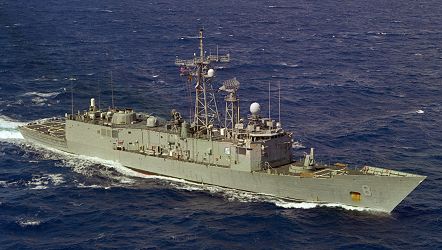
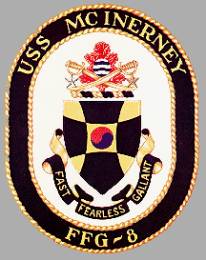
USS McINERNEY was the second ship in the OLIVER HAZARD PERRY class of guided missile frigates. USS McINERNEY is the first "long hull" version in her class. Since 1999, the ship was part of the NRF training naval reservists. USS McINERNEY's awards include the Combat Action Ribbon, the Coast Guard Operational Meritorious Unit Citation, the Navy Unit Commendation, the Meritorious Unit Citation with Bronze Star, the National Defense Service Medal, the Sea Service Deployment Ribbon with four Bronze Stars, the Kuwaiti Liberation Medal and the Southeast Asia Service Medal with two Bronze Stars. Decommissioned on August 31, 2010, the McINERNEY was transfered to the Pakistani Navy the same day and was recommissioned as PNS ALAMGIR (F 260).
| General Characteristics: | Awarded: February 27, 1976 |
| Keel laid: January 16, 1978 | |
| Launched: November 4, 1978 | |
| Commissioned: November 19, 1979 | |
| Decommissioned: August 31, 2010 | |
| Builder: Bath Iron Works, Bath, Maine | |
| Propulsion system: two General Electric LM 2500 gas turbines, two 350 Horsepower Electric Drive Auxiliary Propulsion Units | |
| Propellers: one | |
| Blades on each Propeller: five | |
| Length: 453 feet (138 meters) | |
| Beam: 47 feet (14.32 meters) | |
| Draft: 24,6 feet (7.5 meters) | |
| Displacement: 4,100 tons | |
| Speed: 28+ knots | |
| Aircraft: two | |
| Armament: one | |
| Crew: 17 Officers, 195 Enlisted |
Crew List:
This section contains the names of sailors who served aboard USS McINERNEY. It is no official listing but contains the names of sailors who submitted their information.
USS McINERNEY in the News:
History of USS McINERNEY:
Since commissioning on 15 December 1979, McINERNEY has performed well in every facet of its capabilities. McINERNEY was selected as the Navy's test platform for the LAMPS MK III Helicopter in the first two years of her service, and her pioneering efforts in Anti-Submarine Warfare earned her a Meritorious Unit Citation.
McINERNEY departed for a Mediterranean/Indian Ocean deployment in November of 1982. This first major deployment included support of the Multi-National Force in Beirut, and a crossing of the equator en route to Diego Garcia, earning her a Navy Expeditionary Medal. McINERNEY returned from deployment in May of 1983, and completed a Selected Restricted Availability period from August 1983 to January 1984.
The first few months of 1984 were spent conducting Refresher Training and Law Enforcement Operations. McINERNEY received a Coast Guard Operational Meritorious Unit Citation for her efforts in law enforcement.
Workups for a second deployment were completed, and in October of 1984, McINERNEY was underway for deployment to the Middle East in the midst of the Iran/Iraq Tanker War. McINERNEY returned from the Middle East in March of 1985, and continued operations in support of law enforcement and naval operations.
In May of 1986, McINERNEY transited to Boston to commence an extended Selected Restricted Availability period during which the AN/SQQ-89(V)2 Anti-Submarine Warfare Suite, fin stabilizers, the Recovery, Assist, Securing and Traversing (RAST) system and single audio system were installed.
McINERNEY completed the availability period in June of 1987, and once again commenced workups and Refresher Training.
In August of 1988, McINERNEY was underway for her third deployment - this one to the Mediterranean. This deployment was highlighted by McINERNEY being awarded the COMSIXTHFLT "Hook Em'" Award for excellence in Anti-Submarine Warfare and a Meritorious Unit Citation. McINERNEY returned from the Mediterranean in February 1989, and departed for the Northern Atlantic in the spring of 1989. Anti-Submarine Warfare operations led the McINERNEY above the Arctic Circle, and McINERNEY returned to Mayport in May of 1989.
Another Selected Restricted Availability, more Refresher Training, and workups followed, with a deployment to the Middle East in January 1991.
After brief ASW operation in the Mediterranean Sea, for which McINERNEY was awarded her second "Hook Em'" Award, McINERNEY entered the Persian Gulf in support of coalition forces against Iraq. McINERNEY performed in every warfare area during the conflict, including convoy escort, mine, anti-air and anti-surface operations. McINERNEY earned the Navy Unit Commendation, the National Defense Service Medal, the Southwest Asia Service Medal with Bronze Star, and the Kuwait Liberation Medal for her wartime service.
The ship returned from the Middle East in July of 1991, after escorting more than 50 merchant vessels through the mine-swept waters to Kuwait ports. Her continued, proven prowess earned her the Battle "E" for efficiency, and the COMNAVSURFLANT ASW Award, designating her as the top AN/SQQ-89 configured ASW platform on the East Coast. McINERNEY conducted another Selected Restricted Availability period from September to December 1991.
McINERNEY again deployed to the Mediterranean and Red Seas on October 7, 1992, where she conducted Maritime Interception Operations with multinational forces. The frigate returned home to Mayport on April 7, 1993.
From September to October 1993, McINERNEY conducted Counter-Drug Operations in the Caribbean Sea and in January 1994, she returned to the Caribbean Sea to enforce UN sanctions in support of Operation Support Democracy. In April and May 1994, during preparations for her summer deployment to Central and South America, McINERNEY flexed her Combat Systems muscles in Exercise Agile Provider, a multi-force exercise off the coast of North Carolina before departing on UNITAS 35-94 in July, during which she circumnavigated the South American Continent and transited the Panama Canal.
In February 1995, McINERNEY participated in Exercise Strong Resolve, a NATO exercise in which she again operated above the Arctic Circle.
USS McINERNEY, with the assistance of the Colombian Navy and U.S. Coast Guard, seized approximately 2,200 pounds of cocaine, one 40-foot boat and arrested four people after chasing down a vessel Nov. 10, 1997. McINERNEY, with a Coast Guard law enforcement detachment on board, sighted the 40-foot boat heading north about 105 miles north of Colombia.
In 1999, McINERNEY took part in UNITAS off South America.
McINERNEY's humanitarian efforts include assisting the tug TAURUS in the Jacksonville Operating Area, transferring a wounded merchant seaman during the Tanker War, rescuing Sailors from the sinking motor vessel JENNEASTAR in the Mediterranean, and escorting merchant shipping carrying needed supplies to the ports of Kuwait through mine-swept channels in the aftermath of Operation DESERT STORM.
USS McINERNEY Cruise Books:

About the Frigate’s Name, about Vice Admiral Francis X. McInerney:
Francis X. McInerney was born on 28 March 1899 in Cheyenne, Wyoming. He was commissioned from the U.S. Naval Academy in June 1929. As a junior officer, his tours of duty included the ships, USS NEW MEXICO, USS BURNS, USS WILLIAMSON, and USS DOBBIN.
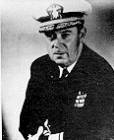 In 1935, he received the degree of Bachelor of Laws from George Washington University Law School. Subsequent tours included USS CONCORD, and instructor at the Post-Graduate School, Annapolis, Maryland.
In 1935, he received the degree of Bachelor of Laws from George Washington University Law School. Subsequent tours included USS CONCORD, and instructor at the Post-Graduate School, Annapolis, Maryland.
VADM McInerney assumed command of USS SMITH in May 1940, and was commanding that destroyer when the United States entered World War II. Later he was assigned to the ANZAC Squadron in the South Pacific and, as senior officer in destroyers, participated in the early strikes in the Solomons and the Battle of the Coral Sea.
In March 1943, he assumed command of Destroyer Squadron 21. He led his ships in the Solomons in the First and Second Battles of Kula Gulf. He was awarded the Bronze Star with Combat "V," the Navy Cross, Presidential Unit Citation, the Silver Star, and the Legion of Merit with Combat "V".
In August 1943, VADM McInerney was assigned as Senior Representative of Commander Destroyers in the South Pacific, and in March 1944, was named Chief of Staff for Commander Operational Training Command, Pacific Fleet. He assumed command of the battleship USS WASHINGTON in June 1945. In October 1946, VADM McInerney reported as Commanding Officer of the Naval Receiving Station, Treasure Island, California. He assumed command of Cruiser Division Three in March 1949. In January 1950, he became Commander Amphibious Training Command, Pacific Fleet. Subsequently, he commanded Amphibious Group Three, Pacific Fleet, and Service Squadron Three.
VADM McInerney's operations in the Korean War as Commander Joint Amphibious Task Forces Seven, Seventy-Six and Ninety-Two earned him the National Defense Service Medal, Korean Service Medal, and the United Nations Service Medal.
In May 1953, he became Senior Member, Board of Naval Inspection and Survey, West Coast Section. In October 1954, he was assigned as President of the Permanent General Court Martial, Eleventh Naval District. He retired 30 June 1955.
VADM Francis X. McInerney died on 24 June 1956 in San Francisco, California.
About the Frigate’s Coat of Arms:
 The Coat of Arms for MCINERNEY symbolizes Vice Admiral Francis Xavier McInerney's successful naval career.
The Coat of Arms for MCINERNEY symbolizes Vice Admiral Francis Xavier McInerney's successful naval career.
The shield's dark blue and gold colors, traditionally associated with the United States Navy, represent the sea and excellence, respectively. The dark blue cross refers to the award of the Navy Cross, and in conjunction with the Taeguk, alludes to the medal of the Military Order of the Taeguk given by the Republic of Korea for Admiral McInerney's services to that Republic during the Korean War.
The crest's coral and fountain (an heraldic symbol for water) refer to the Battle of the Coral Sea. Admiral McInerney was in command of the Destroyers ANZAC Force, which took an active role in the battle during World War II. The two swords are adapted from the Surface Warfare Insignia and refer to both the fighting nature of a fast frigate guided missile destroyer and to Admiral McInerney's distinguished naval service. The two stars, representing the awards of the Silver Star and the Bronze Star Medals, further symbolize the continued excellence, and the achievements, of Admiral McInerney throughout his career.
MOTTO:
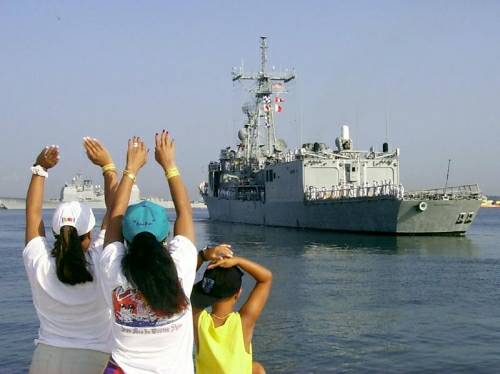
USS McINERNEY Patch Gallery:
 |  | 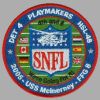 |
USS McINERNEY Image Gallery:
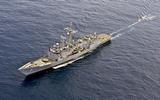 | 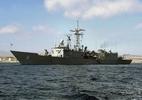 | 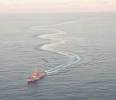 | 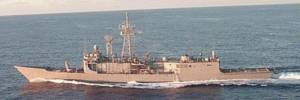 | |
 | 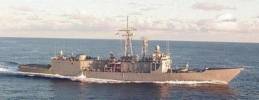 |  | ||
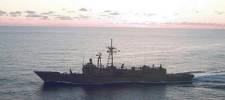 | 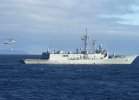 |  |  | |
 Back to Frigates list.
Back to Frigates list.  Back to ships list.
Back to ships list.  Back to selection page.
Back to selection page.  Back to 1st page.
Back to 1st page.